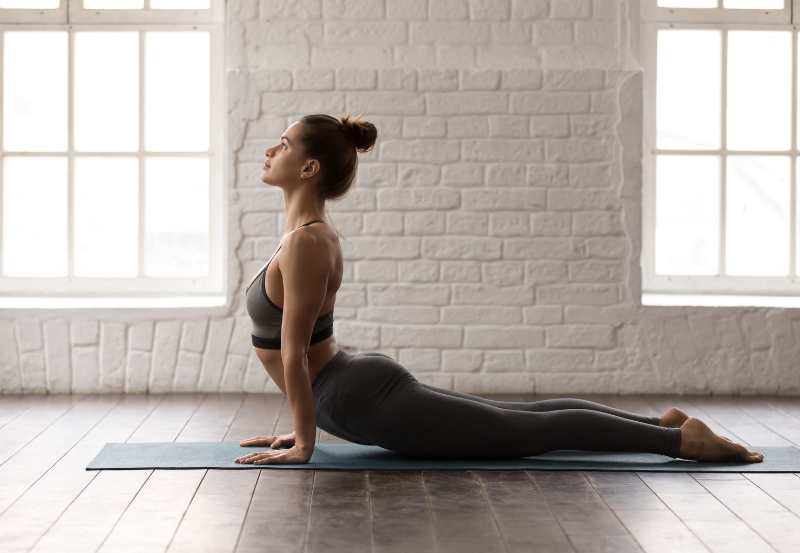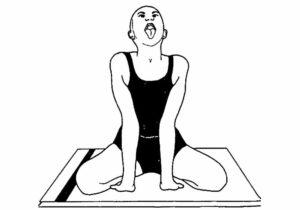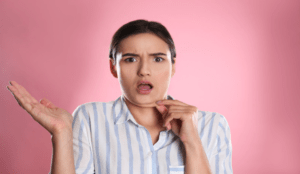Bhujangasana, commonly known as the Cobra Pose, is a rejuvenating yoga position that offers a wide range benefits of physical and mental health. In this blog, we’ll explore the steps by step to perform Cobra pose, delve into its numerous advantages, and discuss some precautions to keep in mind while practicing the yoga pose.
Steps to Perform Bhujangasana (Cobra Pose)
Step 1: Starting Position
On a comfortable yoga mat, begin by lying flat on your stomach. Maintain erect posture with your legs extended and position your palms flat on the floor just below your shoulders. The elbows should be pointed backward and close to the body.
Step 2: Placing the Hands
Using the power of your back muscles, softly press your palms into the mat as you inhale. To improve stability and support, make sure your fingers are widely spaced apart. Instead of packing the hands with too much weight, spread it evenly.
Step 3: Positioning the Legs and Feet
Press the tops of your feet and thighs firmly onto the floor while maintaining a pointed-toe position. Without raising your knees, contract your leg muscles. During the posture, this stance aids in stabilizing the lower body.
Step 4: Lifting the Chest and Head
Start the motion by raising your chest slowly off the floor as you exhale. Make use of the power in your back muscles, particularly the lower and middle back muscles. Raise your head and look forward at the same time.
Step 5: Maintaining the Pose
For a few breaths, hold the Cobra Pose while keeping your shoulders loose and away from your ears. Keep your elbows slightly bent to give your front torso a little stretch. Make use of your core muscles to stabilise yourself and support your spine.
Benefits of Bhujangasana (Cobra Pose)
1. Strengthens the Back Muscles
The back muscles, particularly the spine, may be strengthened using bhujangasana, which is well known for this. Regular use of this pose strengthens the muscles that support the spinal column, which reduces back pain and enhances posture.
2. Stretches the Chest and Abdomen
Deep chest and abdominal stretches are used in the Cobra Pose to widen the chest cavity and expand the lungs. This can be especially helpful for people who spend a lot of time sitting or slouching down since it prevents the shoulders from rounding and helps to improve posture in general.
3. Improves Digestion
Bhujangasana helps reduce constipation and improves digestion by gently squeezing the abdominal organs. In addition to massaging the kidneys and adrenal glands, the position also helps the body detoxify itself by massaging those organs.
4. Tones the Buttocks
Bhujangasana gives your buttocks a good workout as you contract your gluteal muscles and elevate your chest. The muscles in this area may be toned and strengthened with regular practise of this position, which will result in a stronger and more sculpted look.
5. Relieves Stress and Fatigue
The energising and revitalising qualities of bhujangasana on the body and psyche are well recognised. It encourages a sense of peace and mental clarity by helping to alleviate tension and anxiety by opening the heart centre and enlarging the chest. For those who are stressed, tired, or mildly depressed, this position might be quite helpful.
Precautions to Consider
Bhujangasana has a lot of advantages, but it must be done carefully and with awareness of the following safety measures:
1. Avoid Overextension of the Spine
Avoid bending the spine too far back when elevating the chest and head. The neck and lower back may be strained by overextension. Instead, concentrate on extending the spine and keeping the stretch pleasant.
2. Take Care with Neck Injuries
When executing Bhujangasana, anyone with neck or cervical spine problems should take extra care. It is advised to maintain a forward look and refrain from overstretching or hyperextending the cervical spine in order to protect the neck.
3. Skip the Pose During Pregnancy
Bhujangasana should not be performed if a woman is pregnant, especially later in the pregnancy. Prioritising the mother’s and the baby’s safety and comfort is crucial. For appropriate adjustments or alternate positions, speak with a certified pregnant yoga teacher.
4. Consult a Healthcare Professional if Needed
Before introducing Bhujangasana into your routine, it is essential to speak with a healthcare provider or a trained yoga instructor if you have any pre-existing medical ailments or concerns. They may provide you personalised advice based on your unique requirements and constraints.
Tips for Practicing Bhujangasana
To make the most of your Bhujangasana practice, keep the following tips in mind:
1. Warm-up Before Attempting the Pose
Warm up your body with some easy stretches or other yoga positions before doing Bhujangasana. This aids in preparing the joints and muscles for the deeper stretch provided by the Cobra Pose.
2. Engage the Core Muscles
Engage your core muscles throughout the position to keep your body stable and support your spine. This not only safeguards your back but also makes the asana more effective.
3. Breathe Smoothly and Deeply
While holding Bhujangasana, concentrate on keeping a steady, deep breath. As you raise your chest, inhale; as you lower it again, exhale. Deep breathing increases the whole experience of the position by calming the mind and body.
4. Modify the Pose if Necessary
You can alter the position by keeping your forearms on the floor and elevating your upper body slightly if you find it difficult to lift your chest completely off the ground. You may progressively work on raising higher and stretching the position as your strength and flexibility increase.
Conclusion
Bhujangasana, often known as the Cobra Pose, is a potent yoga asana that has many mental and physical advantages. You can strengthen your back, correct your posture, and feel rejuvenated by taking the right precautions and exercising mindfully. Keep in mind to approach the posture cautiously and to take into account any restrictions or safety measures unique to your body. Bhujangasana practise on a regular basis can improve your general well-being when combined with a comprehensive yoga regimen.
FAQs (Frequently Asked Questions) About Bhujangasana
Bhujangasana can help relieve mild to severe back pain by enhancing spinal flexibility and strengthening the back muscles. However, if you have significant or persistent back pain, it’s crucial to practise with perfect alignment and seek medical advice.
As a general rule, novices should start by holding the posture for 15 to 30 seconds, and as they get more comfortable, they can progressively extend the time. Aim to hold the position for 30 to 60 seconds while inhaling deeply and deliberately.
Yes, novices may perform Bhujangasana. It’s crucial to begin with appropriate alignment, pay attention to your body, and gradually build up the pose’s intensity and length over time.
The body may be complemented and prepared for Bhujangasana by asanas like Child’s Pose (Balasana), Cat-Cow Pose (Marjaryasana-Bitilasana), and Sphinx Pose (Salamba Bhujangasana). A balanced approach may be achieved by include a range of backbends and counterstretches in your practise.
Bhujangasana should be performed carefully by those who have spinal injuries, in consultation with a medical professional or a certified yoga instructor. To guarantee the person’s safety and wellbeing, adjustments or alternate positions could be advised.
Learn to Know More So You Can Visit Best Yoga School in India and Join 200 Hour Yoga Teacher Training in India and Aerial Yoga Teacher Training in India and Kundalini Yoga Teacher Training in India and Ayurveda Yoga Teacher Training in India and Ashtanga Yoga Teacher Training in India




